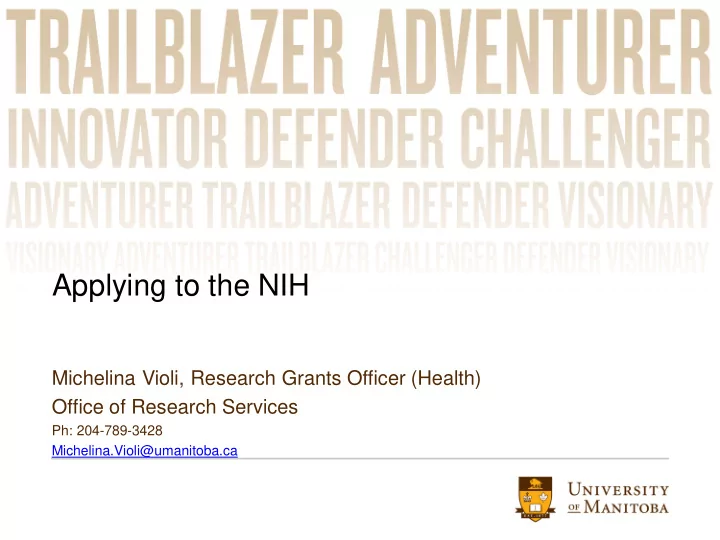

Applying to the NIH Michelina Violi, Research Grants Officer (Health) Office of Research Services Ph: 204-789-3428 Michelina.Violi@umanitoba.ca
Presentation Outline • CIHR grants vs. National Institutes of Health (NIH) grants. • Demystifying how to search for funding opportunities at the NIH • Registering for eRA Commons, Grants.gov and other US systems • Applying for NIH grants • Timelines for the application process
CIHR vs. NIH: Similarities and Differences CIHR • 13 institutes dedicated to a specific area of focus. • approximately $1 billion/year to support health research in Canada. NIH • 27 Institutes and Centers, each with a specific research agenda, often focusing on particular diseases or body systems. • invests nearly $32.3 billion/year in medical research worldwide. • •More than 80% of the NIH's funding is awarded through competitive grants.
Funding Mechanisms Both CIHR and NIH have investigator-initiated and targeted funding mechanisms CIHR • Open Operating funding and targeting funding (Catalyst, Operating, Team and other grants) advertised on ResearchNet NIH • Programs such as R01, R21 and U01 can be investigator-initiated or solicited via a Request for Application in a targeted area advertised on grants.gov
NIH Review Criteria and Process • There are no set weights for each criterion: significance, investigator(s), innovation, approach and environment • Each application assigned 1 primary and at least 2 secondary reviewers • Rating scale: 1 (exceptional) to 9 (poor), then multiplied by 10 to get %
Where to begin the search? https://www.grants.gov/web/ grants/search-grants.html
Opportunity found – now, what? How to apply • Start Early! • UM Institution Registrations required (provided by ORS): Data Universal Number System (DUNS) System for Award Management (SAM) NATO Commercial and Government Entity (NCAGE) • PI registrations required prior to grant submission: Grants.gov eRA Commons (for NIH applications) ASSIST (for NIH, FDA, CDC and VA applications) eBRAP (for DoD applications)
Eligibility – Can Canadians apply to NIH opportunities? • Review Funding Opportunity Announcement (FOA) for Eligibility (pay attention to exceptions) • Foreign Institutions may or may not be eligible
eRA Commons
Applying for NIH grants • Two applications portals are available for applying to the NIH: - Grants.gov - ASSIST • ASSIST is the recommended portal for the following reasons: -Multi-user access on same application -Leverages eRA Commons accounts and will pre-populate info -Pre-submission validations and application preview -Track application status in a single system -Ability to copy data to different application package -Supports all NIH competing applications -Integrated NIH messaging (tips, system alerts)
ASSIST – Applying for NIH grants https://public.era.nih.gov/assist/
NIH resources https://grants.nih.gov/grants/oer.htm
NIH Application Deadlines • NIH Applications are accepted 3 times (cycles) per year depending on the type of grant (ie. R01, R21, P01, etc.) so if you miss one deadline, you can submit a the next cycle deadline. https://grants.nih.gov/grants/how-to-apply-application- guide/due-dates-and-submission-policies/due-dates.htm
NIH FOA details
NIH Application Forms
ASSIST
Suggested Timelines for Grant Proposal Development Things to consider when applying to US funding opportunities: • Begin preparing your applications well in advance of the deadline (expect a longer lead time: applications are complex). • Use available resources: research facilitators, research grants officers, colleagues who can peer-review. • Remember to use set indirect costs (institutional costs) of 8%. • Required sub-site agreements if working with collaborators at other institutions (must be in place well in-advance of agency deadline). ORS can help facilitate this.
Achieving Funding Success • Research funding is highly competitive. • Your proposal reflects your abilities as a researcher. • Highly conceptualized presentation of objectives, well-laid out methodology and expected outcomes are critical. • Contact ORS as early as possible in the process. -Some applications may require additional institutional actions (e.g., institutional registration, creation of new agency accounts, institutional certifications, etc.) so the more time the better.
Grant or Contract? • A grant is unrestricted funds. researchgrants@umanitoba.ca • A contract is anything where the University is accepting risk, or has an obligation. Some examples include: - Ownership, IP - Publication requirements - Indemnity - Funds contingent on a deliverable or milestone researchcontracts@umanitoba.ca For example, NIH prime awards are grants but NIH sub-recipient awards are contracts.
ORS Internal Deadlines • NIH and DoD must be submitted to ORS, with FAAF, 10 business days in advance of agency deadline. Contact ORS as soon as possible in the process: • Allows sufficient time for any additional institutional actions and registrations • If sub-sites are included in proposal, additional documentation is required including collaboration agreements with the other institutions.
Questions?
Recommend
More recommend